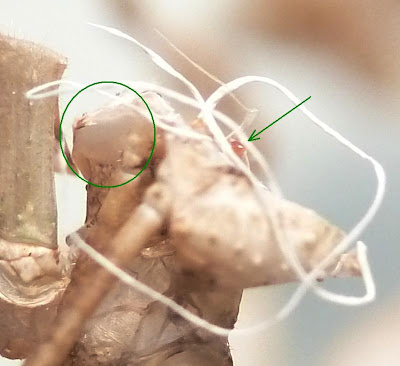Back to the small beetles today - I've just finished identifying all
the specimens that I received by post a while back (yay!) - most were fairly common, though a few such as the chrysomelid
Phyllotreta punctulata were scarcer (in Britain at least). However, 'common' does not necessarily equal 'easy to identify' and here are a couple of examples from the family Chrysomelidae (leaf-beetles). The first is a deep metallic blue beetle about 4mm in length (without appendages).
 |
| The first specimen, a shiny blue chrysomelid beetle about 4mm long. |
One very clear feature here is the pronotum being considerably narrower than the elytra. The length of the pronotum is about 0.4 that of the elytra and the elytra are about 1.6-1.7 times as long as they are wide. The overall form is distinctive and indicates it is a member of the subfamily Criocerinae.
 |
| A close-up of the pronotum with key features indicated. |
Looking more closely, the green arrow on the left points to a rounded but definite angle (i.e. the side if the prronotum is not evenly rounded) while the red bracket shows that the constriction near the rear of the pronotum lines up with the furrow across its upper surface. These features separate it from the genus
Lema (which would have the constriction near the rear of the pronotum and not in line with the furrow, and would also have sharper angles on the side), and hence show it to be in the genus
Oulema - there is a good page separating
L. cyanella and
O. obscura here which also covers some of their taxonomic confusion. In Britain there are three
Oulema species which are this colour -
obscura,
septentrionis and
erichsoni.
O. obscura (often known as
O. gallaeciana in continental Europe) is generally considered to be a fairly short species with a pronotum 0.3 times as long as the elytra and with elytra 1.25 times as long as wide. So, using these features, it would appear to be one of the other two, more elongate, species. However, there is a problem here -
O. septentrionis is found in Ireland, but not on the British mainland while
O. erichsoni has, since the early 20th century been found only in Somerset (a county in the west of England). This specimen was collected in Essex (a county in the east of England) which means one or more of a few things - either it is one of the above two species well away from its usual area (this is unlikely), it is a species new to Britain (very unlikely), the key is not correct (possible - I'm using my own key which is not yet complete) or it is an unusual specimen of
O. obscura (also possible).
So, I decided to start with the specimen and looked for some other images which might show some variation in length:width ratio. This turned out to be quite simple - some pages such as
this one showed specimens of similar proportions, while Google Images provided many which were more elongate still (though of course these may not all be accurate identifications). So, I am certain that this is indeed
O. obscura, though I will add a note to my key about the variation in proportions.
The second specimen is smaller (about 2.3mm without appendages) and less brightly coloured and is in the genus
Aphthona - the leg shown below is twisted but the tiny tibial spur is on the outer side of the lower edge (if in the middle of the lower edge, it would be in the genus
Phyllotreta).
 |
| The Aphthona specimen - a male with the aedeagus partly protruding. |
In Britain, only three Aphthona species are this colour rather than being black/blackish -
lutescens,
pallida and
nigriceps. Some fine details of the head, including its colour (not black - actually paler than shown here) strongly suggest that this is
A. lutescens, however this species generally has a partly darkened elytral suture (i.e. where the wing cases meet) as shown
here. This does not appear to be the case here, but a very close examination showed that the suture did have a hair-thin dark line and that the darker areas such as the femora and apical half of the antennae were starting to darken. Therefore, this appears to be a teneral specimen of
A. lutescens i.e. one that has only recently emerged as an adult and has yet to fully develop its coloration. Teneral specimens can often prove problematic as normally distinctive features may be missing. However, I wanted to check to be absolutely certain, so I looked at the aedeagus which was helpfully protruding.
 |
| The aedeagus of the probable A. lutescens. |
Looking in Warchalowski (2003), the aedeagus is shown to have a small construction near the end forming a tiny protuberance. This is present here and is not seen in
A. nigriceps or
A. pallida, hence
A. lutescens is confirmed and provides a helpful reminder of the need to take care with teneral specimens.
So, with the current batch of specimens identified and returned to their collector, this phase of the 'What's in the box?' series has come to a conclusion, but more will no doubt appear, so watch this space!
References
Warchalowski, A. (2003).
Chrysomelidae. The Leaf Beetles of Europe and the Mediterranean Area. Natura Optima Dux, Warsaw.






















































